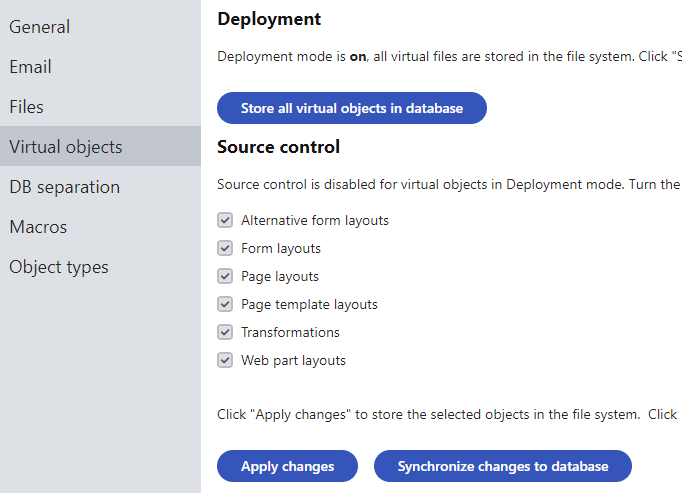Deployment mode for administration virtual objects
The Xperience administration application provides a way to store virtual objects in the file system in addition to the database. This can be useful if you need to prepare your project for deployment, or if you want to manage the code of objects using a source control system.
Virtual objects that require compilation include the following:
- Alternative form layouts (ASCX type)
- Page layouts (ASCX type)
- Web part layouts
To deploy the administration project to another server:
Open the System application.
Select the Virtual objects tab.
Click Store all virtual objects in file system.
- The system saves all virtual objects (alternative form layouts, page layouts, and web part layouts) on your disk.
- The target folder is ~/CMSVirtualFiles.
In Visual Studio, manually include the CMSVirtualFiles folder into the CMSApp project:
- Click Show all files at the top of the Solution Explorer.
- Right-click the CMSVirtualFiles folder and select Include in Project.
- Rebuild the CMSApp project.
Publish (and compile) the files. See Precompiling websites for more information.
- At this time, you can still edit the code of objects in the Xperience user interface, but any changes will require you to compile the files again.
When deployment mode is OFF:
- The storage location of the virtual objects depends on the settings of the Source control options.
When deployment mode is ON:
- All objects that require compilation are moved into the file system on the local disk. The target folder is ~/CMSVirtualFiles.
- You can edit the code of objects in the user interface. Changes are saved into the files immediately.
- You can edit the object files in Visual Studio or another external editor.
- To move objects back into the database, click Store all virtual objects in database (deletes the files on the disk).
- You can configure the Source control options for objects that do not require compilation.

Limitations
- Do not apply hotfixes while deployment mode is on. Disable deployment mode before you start the hotfix procedure, and re-enable it once the hotfix is applied.
- The Staging feature has limited support for synchronizing object code when using deployment mode:
- On source servers, staging tasks are generated only if you edit code in the Xperience UI or after you synchronize changes from files into the database.
- On target servers, deployment mode must be off if you wish to use incoming staging tasks to update object code.
Error when disabling deployment mode
When disabling deployment mode (returning virtual files to the database), you may encounter the “The directory is not empty.” error. This occurs if the web application is currently using some of the virtual files, and cannot delete the content of the CMSVirtualFiles folder as a result.
The error does not affect the functionality of virtual files – the system correctly disables deployment mode and all virtual file data is returned to the database. The only consequence is that the CMSVirtualFiles folder and some of its content remain on your file system. You can try deleting the folder manually at a later point.